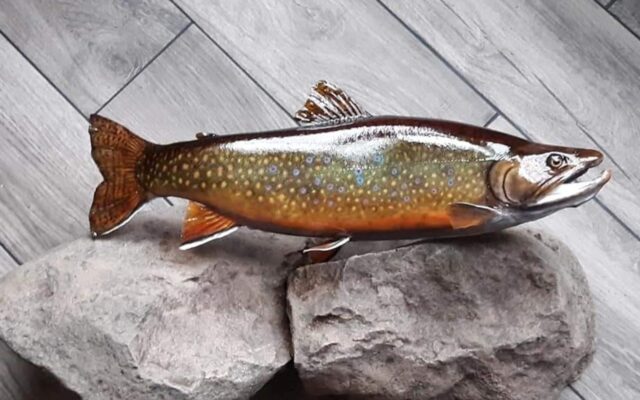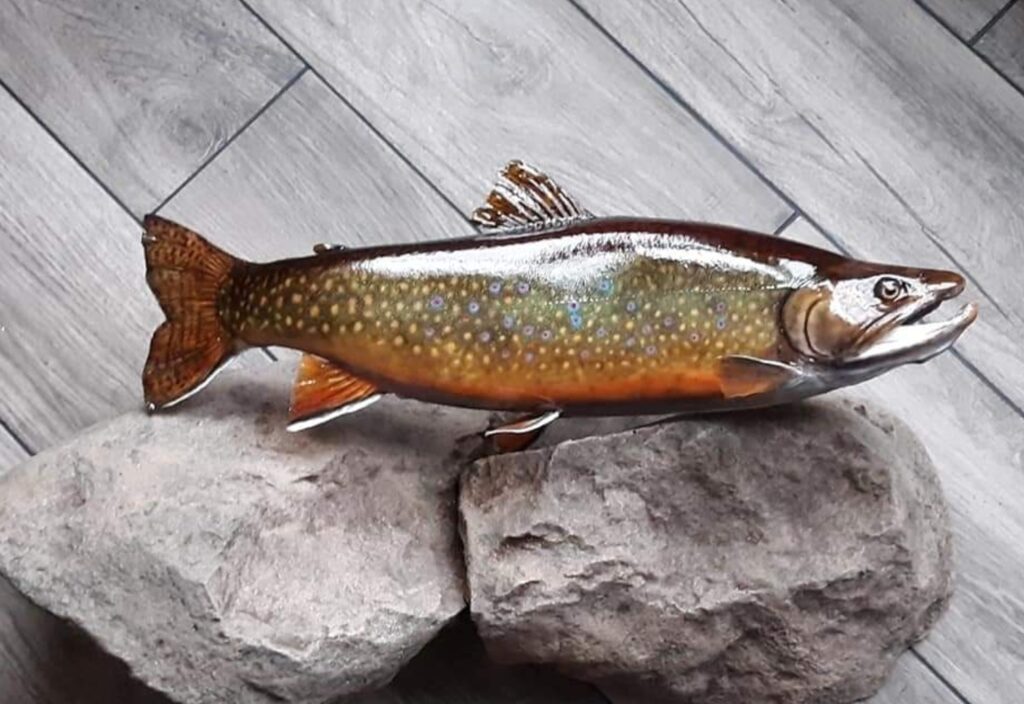
That fish on your buddy’s wall may not be real
By Julie Harris, Bangor Daily News Staff
Gene Bahr of Sebago quit taxidermy cold turkey after 47 years of preserving people’s memories through thousands of life-like mounts of animals, birds and fish.
He worked hard to perfect his craft, aspiring to be like David Footer of Lewiston, the state’s premier fish taxidermist in the 1970s.
Bahr, 74, became a Maine-licensed taxidermist in 1976. It took him 16 years to earn Footer’s respect, but his goal was to be his equal, Bahr said.
He eventually surpassed Footer’s work, he said. Fish skin mounts were his specialty for 24 years, although he continued to do mammals and birds. In 1990, he began to carve fish out of wood as a side interest. He quit doing fish skin mounts for good in 2000.
“One day I looked in my freezer and it was full of large, dead fish,†he said. That was when he stopped taking taxidermy fish orders.

TROUT SKIN MOUNT — Tim Sansoucy of Tim’s Taxidermy in Alfred does fish skin mounts and replicas. This is a trout skin mount.
Now he has one specialty. He creates wood replicas of fishermen’s favorite catches.
He is not alone. More taxidermists are turning away from traditional skin mounts of fish and creating replicas instead, mainly because of the surging interest in catch and release fishing, several taxidermists said.
Fishermen practice catch and release for several reasons, but one of the most common is to allow the fish to get bigger. Some don’t eat fish, but love the fishing experience. It’s becoming so popular that it’s even creating fish population problems in places such as Moosehead and Sebago — Maine’s two biggest lakes.
But catching the fish of a lifetime and letting it go back into the water is difficult to do when the fisherman wants to keep a tangible memory. That’s where replicas come in. Fishermen can quickly measure the length and girth of the trophy fish, take some good pictures and release the catch back into the lake or pond.
The replica specialist can use premade forms, often out of fiberglass, urethane or some other material, and paint the particular fish’s design on the mold. But Bahr is the only one in the state who carves his individual molds out of wood and paints on even the tiny details of the trophy fish he’s working on.
Traditional taxidermy has been regulated in Maine since 1929. Taxidermists go to school to learn how to preserve animals, federal and state fish and game laws, how to deal with people and other related skills.
They also undergo a rigorous licensing process through the Maine Department of Inland Fisheries and Wildlife and the Maine Association of Taxidermists, including an interview with a warden, an oral exam with a licensed taxidermist, a written exam and perhaps samples of work already done.
The careful scrutiny is because of the state’s strict laws about possession of wildlife and how much the taxidermists have on their property all of the time, according to MDIF&W spokesman Mark Latti. They also need to be familiar with special federal regulations on waterfowl and transporting hides.
There are between 225 and 250 licensed taxidermists in Maine, according to Tim Sansoucy of Alfred, president of the Maine Association of Taxidermists. Some people have their licenses but don’t practice, and others let them lapse in favor of replica mounts and other endeavors, he said.
Many states don’t require licensing, he said.
There are no taxidermy schools in Maine — the closest is New Hampshire — but the Maine Association of Taxidermists offers some classes. Training costs from $9,000 to $12,000. It’s also expensive to set up the shop for traditional taxidermy, according to Josh Hatley, owner of Mainely Taxidermy in Bradford.
Replica production is not regulated, there is less equipment and its popularity is new enough that it doesn’t have industry standards yet, Hatley said.
That means replica production can range from machine painting the fish form an accepted likeness of whatever species it is to the meticulous work Bahr does. Customers are on their own to research what the end quality might be.
It’s also not inexpensive. A 22-inch brook trout could cost $2,200, for example. But as Bahr said, you are paying for his experience as a fisherman and a taxidermist. He has done more than 500 carvings.
“This is my passion — something I do better than just about anyone else. That’s a God-given talent. It amazes me that I can do that,†he said. “I’m just a good fish carver. That’s all.â€
It’s not unusual for taxidermists to have backlogs. Most are a year or two out from when the fish is brought in, said Hatley, who moved to Maine from North Carolina to run Witter Farm for the University of Maine.
Most taxidermists charge by the inch for fish, approximately from $31 to $42 per inch.
“Taxidermy is an art form and it takes patience from the client,†he said. Taxidermists want to make your dreams come true. We try to make a memory.â€
Replicas are a quicker turn-around than traditional taxidermy, but the increased interest catch and release created still causes a backlog, he said. Hatley took courses and watched YouTube reels to learn how to do taxidermy. Someone gave him about 30 fish to practice his skills. Then replicas became more popular.
Hatley does occasional skin mounts now, but most of his fish are replicas. There are good reasons to do replicas, he said.
A fisherman may want to let the fish go back into the gene pool, or may want to eat the catch. From an industry perspective, there’s no deterioration or skin breakdown over time, except a little fading of the paint. The taxidermist is not exposed to harsh chemicals and fish oil doesn’t coat tools and equipment in the shop.
Replicas also expand the taxidermist’s clientele. Anyone can preserve a fish memory. All you need are approximate measurements and a photo. Hatley said he had a client from Texas who had a special memory of fishing as a teen in Maine, and brought in a 50-year-old photo of a fish he caught then to have a replica made.
Clients also may get replicas of federally protected fish like sturgeon and Atlantic salmon, where they cannot legally own actual fish of those species.
Ryan Rhodes of North Rhodes Taxidermy in Searsport doesn’t do a lot of fish, but what he does are replicas — maybe a dozen a year. North Rhodes is the largest taxidermy shop in Maine, with four employees besides the owner. He specializes in larger animals, especially safari kills. About half of his clientele are from places other than Maine.
Besides the switch to fish replicas from skin mounts, he has seen other changes too. Shipping, supply chain issues and general costs have doubled since 2020 — the year COVID-19 hit the United States. There is a lot of burnout in taxidermy, he said. People try it for a few years and give it up.
He sees replicas staying part of the business because the technology and products are better than the skin mounts, he said
Sansoucy of Tim’s Taxidermy in Alfred does 85 percent skin mounts and 15 percent replicas. He does more than 100 fish a year with one full-time employee and the waiting period right now is three years. He is well-known for his skin mounts and recently began turning fish away.
He prefers replicas for warm water fish like bass because their big scales chip off the skin too easily, making it difficult to do a traditional mount.
Sansoucy is a four-time winner of the Northern New England Taxidermy Championship. This year’s championship is coming up on July 26-27 at Jeff’s Catering in Brewer.
One of the pitfalls of replica mounts is trying to get the exact size fish mold needed. Sansoucy is working with a company out West on molds for brook trout and Atlantic landlocked salmon, two species that are plentiful in Maine but not other places. Now they modify a brown trout mold for those two fish.
Catch and release has been gaining popularity over the last 12-15 years, and there’s been a big push to do reproductions the last five or six, Sansoucy said.
Christian Carlson of Carlson’s Fish Taxidermy in Thorndike let his taxidermy license lapse and he now only does replicas. He has won some ribbons and plaques with his work, beating some traditional taxidermy, and prides himself on being meticulous about the individual details on each fish and keeping them true to species. He handpaints each scale.
He also has a growing fishing lure business, Northeast Troller, so has cut back on his replicas.
Carlson has had some interesting projects, among them a mako shark, a sturgeon and a Kokanee salmon.
His favorite part about doing replicas is learning people’s stories, such as when someone brought in a picture of the last fish caught with their father.
“Sentimentally, it’s the best fish they ever caught,†Carlson said. “It psychs me out mentally because it’s so important to this person. I’ve had some sleepless nights.â€